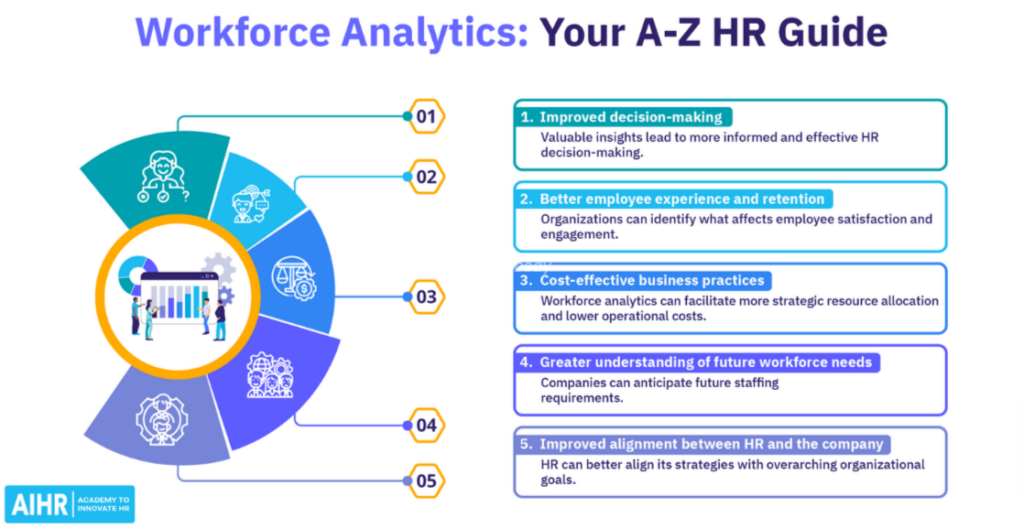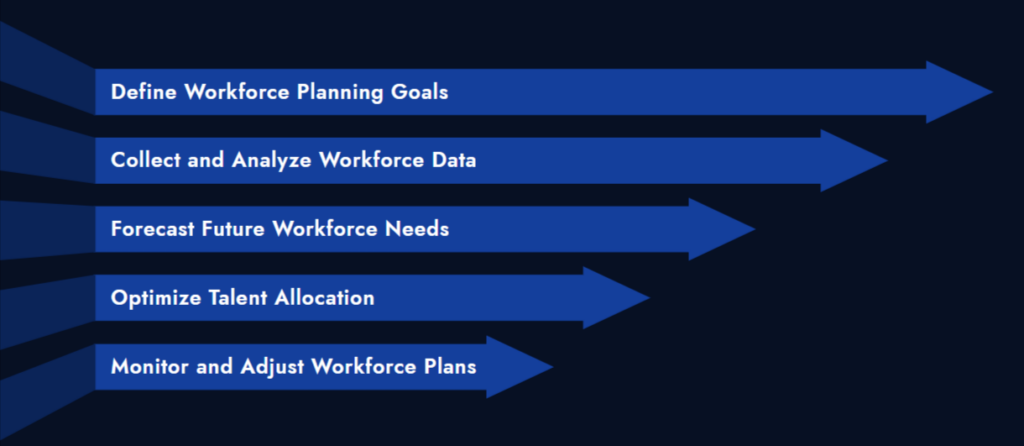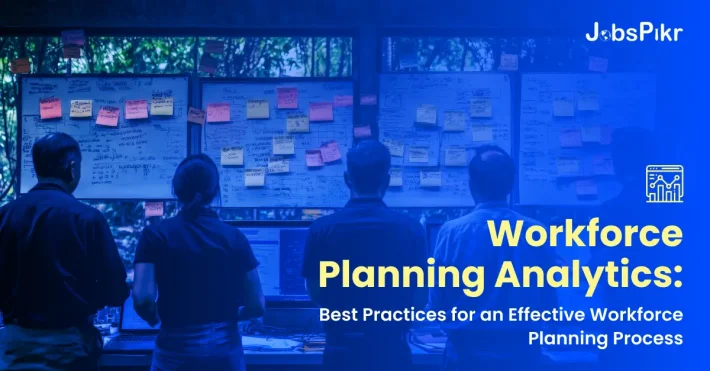In modern business, aligning the workforce to organizational goals is crucial for maintaining competitive advantage. Having the right talent at the right time enables HR leaders to make data driven decisions regarding talent acquisition and retention through workforce planning analytics. Cost effective talent allocation, hiring process improvement, and reduced workforce expenditure can only be achieved through efficient workforce planning processes.
A report published by Deloitte describes that 70% of organizations that implemented workforce analytics reported improved decision making while 60% reported reduced costs in hiring. With such significant implications, organizations need to adopt ensemble workforce planning tools to aid in operational efficiency and foster sustainability of the workforce in the long run.
In this write-up, we define workforce planning analytics, talk about the prevalent gaps in workforce planning, describe ways to establish a data driven workforce planning procedure, and also show the strategic support of workforce planning by JobsPikr’s workforce intelligence tools.
Why Workforce Planning Analytics Is Critical for Business Success?
In the modern world where business environments keep changing, workforce planning analytics have increasingly helped organizations minimize workforce-related problems. Businesses can no longer use traditional methods of workforce planning that are inflexible to changes in the industry and economic environment. Rather, data-driven workforce analytics empowers human resource departments to have better foresight on the workforce that will be needed, manage personnel more effectively, and improve hiring processes. Businesses, therefore, could ensure that employees are positioned where they are most suited, in turn, increasing productivity, cost-saving, and achieving long-term success.

What is Workforce Planning Analytics?
Workforce planning analytics involves using data to anticipate workforce needs, manage labor costs, and optimize recruitment strategies. It allows HR leaders to:
- Forecast workforce demand: Predict talent needs based on business growth and industry trends.
- Identify skill gaps: Determine workforce shortages and plan upskilling initiatives.
- Optimize workforce allocation: Ensure efficient deployment of employees to maximize productivity.
- Improve retention strategies: Use analytics to enhance employee satisfaction and reduce attrition.
- Enhance succession planning: Identify leadership gaps and nurture high-potential employees.
- Strengthen workforce diversity and inclusion efforts: Analyze hiring trends to ensure equitable representation.
A study by McKinsey found that businesses utilizing workforce planning tools see a 25% increase in operational efficiency and a 30% improvement in talent allocation.
Workforce planning analytics encompasses the use of analytics to project labor force requirements, control labor spending, and improve hiring practices. HR executives can use it to:
- Forecast workforce demand: Anticipate required talent in correspondence with company growth and market competition.
- Identify skill gaps: Ascertain existing workforce deficits and strategize training and development to address these deficits.
- Optimize workforce allocation: Deployment of staff in appropriate jobs to improve their performance.
- Improve retention strategies: Analyze and improve employee experience to lessen employee turnover.
- Enhance succession planning: Close leadership gaps and develop employees with strong potential.
- Enhance the diversity and inclusion of the workforce: Monitor recruitment activities to verify enrollment balance.
McKinsey’s research found that companies that use workforce planning tools report 25% greater operational effectiveness and 30% better use of human resources.
Why Workforce Planning is Essential for Business Success?
Effective workforce planning ensures:
- Agility in hiring and recruitment processes to adjust workforce needs quickly.
- Improved workforce productivity and engagement by placing employees in the right roles.
- Enhanced financial planning and budgeting to optimize labor costs.
- Reduced risks associated with workforce shortages by ensuring talent pipelines are well-prepared.
- Increased resilience to economic downturns by aligning workforce strategies with business goals.
“Companies that use workforce planning analytics report a 20-30% reduction in recruitment and labor spending,” claims a report by Gartner.
How Workforce Planning Analytics Solves Hiring & Talent Gaps?
The intricate nature of workforce planning demands constant balancing of human capital needs with supply, recruitment strategies, and financial goals while ensuring the continuity of the organization’s business operations. Most firms struggle with inefficient workforce qualifying processes due to volatile market conditions, lack of skilled employees, and funding limitations.
With workforce planning analytics, companies can turn these challenges into opportunities. Informed decisions as a result of analytics enable human resource teams to address employee shortages in advance, enhance recruitment plans, and make better staffing choices. Here are the primary areas where fundamental challenges of workforce planning exist and how analytics can aid in solving them.
Regardless of the significance of the task, organizations repeatedly face challenges associated with planning the workforce. The following is how workforce planning analytics can aid in overcoming these obstacles.
1. Problems Associated with Predicting Talent Demand
Challenge: Proper hiring forecasting is a major issue for businesses, as they must contend with market shifts along with ever-changing industry dynamics.
Solution: Using predictive workforce analytics, companies can minimize the impact of hiring delays and make sure that their workforce is ready by forecasting hiring needs up to 6-12 months in advance through historical data and current market trends.
2. Shrinking Employee Count and Retention Difficulties
Challenge: Attrition in turnover or disengagement leads to reduced productivity along with higher expenditure in hiring, thus creating a cycle of disengagement.
Solution: Deploying employee analytic tools helps pinpoint turnover rates and allows HR Teams to counter these with retention strategies including enhanced development opportunities, customized benefits, and economic compensation revisions.
3. Inability to Efficiently Allocate Employees
Challenge: Understaffing and overstaffing certain areas due to a lack of proper workforce planning hampers productivity and operational effectiveness.
Solution: Data-based workforce planning tools help elevate productivity while enabling a more efficient distribution of talent. Reducing operational inefficiency by 15-20% balanced shifts and workload funnels through AI enable optimal employee placement based on existing skills and business necessities.
4. Budget Constraints in Workforce Planning
Challenge: Managing workforce costs within a limited budget often becomes a challenge for HR teams, leading to wastage or a shortage of employees.
Solution: With the help of AI technology, organizations can use workforce analytics to plan compensation and training or hiring expenses within the budget. Spending on the workforce is cognizantly aligned with long term business strategies because AI forecasting enabled it.
Guide for Implementing a Workforce Planning Process Using Data Insights
To build a data-driven workforce planning strategy, follow these essential steps:

Step 1: Define Workforce Planning Goals
- Align workforce planning with business objectives and future expansion plans.
- Identify key workforce challenges such as high turnover, skill gaps, and hiring inefficiencies.
- Set measurable KPIs, such as reducing hiring time by 25% or improving employee engagement scores by 15%.
Step 2: Collect and Analyze Workforce Data
- Use workforce planning tools to collect employee performance, turnover, and hiring trend data.
- Leverage external labor market intelligence to benchmark salaries and skill demands.
- Conduct workforce segmentation to understand employee demographics, tenure, and career progression trends.
Step 3: Forecast Future Workforce Needs
- Predict future hiring needs based on business growth projections and industry hiring trends.
- Use AI-driven analytics to anticipate seasonal, geographical, or industry-specific hiring trends.
- Identify upcoming skill gaps and plan workforce training and upskilling programs accordingly.
Step 4: Optimize Talent Allocation
- Implement workforce modeling techniques to balance staffing levels and avoid talent shortages.
- Develop flexible staffing strategies, including contract workers, gig economy talent, and remote teams.
- Ensure strategic succession planning for leadership roles and specialized talent areas.
Step 5: Monitor and Adjust Workforce Plans
- Continuously track workforce performance, hiring efficiency, and cost management.
- Adjust recruitment and retention strategies based on real-time workforce insights.
- Leverage automation and AI-powered workforce analytics for more accurate forecasting and decision-making.
A PwC study found that businesses using data-driven workforce planning strategies reduce hiring inefficiencies by 40% and improve workforce adaptability by 35%.
How JobsPikr’s Workforce Data Support Strategic Workforce Planning?
JobsPikr provides businesses with real-time workforce analytics to drive effective workforce planning. By integrating JobsPikr’s data into HR workflows, companies can:
- Monitor global hiring trends and labor market insights to stay ahead of competitors.
- Identify talent availability and salary benchmarks for competitive recruitment strategies.
- Forecast industry-specific workforce demand and adjust hiring plans accordingly.
- Optimize recruitment strategies with AI-driven insights for data-backed hiring decisions.
Real-World Applications of JobsPikr’s Workforce Analytics
- Technology Industry: A Fortune 500 tech company optimized global hiring strategies, reducing hiring costs by 30% using JobsPikr’s workforce insights.
- Healthcare Sector: A hospital network predicted nurse shortages and improved workforce allocation, reducing staffing gaps by 40% and improving patient care efficiency.
- Retail Industry: A multinational retailer used JobsPikr’s labor market analytics to improve seasonal hiring efficiency, cutting recruitment expenses by 25% and reducing workforce shortages during peak seasons.
- Manufacturing Sector: A global manufacturer leveraged workforce planning analytics to anticipate labor shortages, reducing workforce costs by 20% and ensuring production continuity.
Conclusion
The refinement of operational analytics is revolutionizing how companies manage workforce costs, enhance efficiency, and formulate talent strategy. With insights provided by analytics, companies can formulate a workforce planning process that is effective, meets business objectives, and is responsive to changing market conditions.
Businesses that focus on investing in workforce planning tools have better business outcomes due to streamlining employee agility, recruitment processes, and other HR decision-making functions. As AI-driven workforce analytics progresses, companies that employ real-time labor market information will be at the forefront of workforce optimization.
To enable strategic workforce planning, JobsPikr offers a workforce intelligence platform that provides the necessary insights needed for effective HR decision making.Sign up on JobsPikr today to access real-time workforce analytics and revolutionize your workforce planning strategies!



